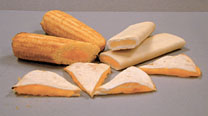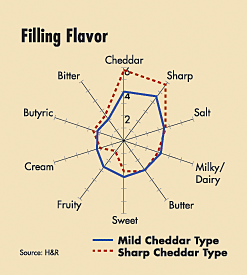When a crust is filled with conventional cheddar cheese and baked, the cheese may escape from the ends of the product. To solve this problem, researchers at Haarmann & Reimer, Teterboro, N.J., have created a cheese filling with a structure that does not run when heated, or crack the dough casing.
Heat Stability
“We had to find the right bulking agents and stabilizers, while keeping the real cheese flavor,” explains Bill Graham, vice president, flavor business unit-fillings.“Our flavor scientists designed a filling system that would remain stable to migration under baking conditions, unlike conventional fat-based cheese fillings.”
The group has formulated the fillings so that the water activity (AW) remains in the .65-.70 range to ensure microbial safety. Preservatives also are included, as an added safeguard. Shelf stability is about six months, at ambient temperatures.

The fillings also have passed sensory and flavor requirements. The sensory department, under the direction of Sherry Genchi, director, sensory evaluation and consumer research, flavor division, used descriptive analysis for texture, taste and color. To derive the optimal result, the team used focus groups and also worked with consumers. The company's product developers, led by James Zhu, senior food technologist, worked to create fillings that were not sweet, had no bitter notes and hit the targets of mild and sharp cheddar.

Customers may also take advantage of the company's consumer research on hand-held snacks, conducted by Anton Angelich, vice president of marketing, sweet goods, flavor division. For example, results indicate men feel comfortable eating large snack items, while women favor smaller foods that won't mess up their makeup or leave a residue on their hands. Neatness also counts for dashboard diners, who need snacks that are easy to open and simple to eat.
For more information:
Bill Graham at 201-462-2292
william.graham.b@bayer.com | www.hr-na.com/flavor
Haarmann & Reimer Write in 230